| dc.contributor.advisor | Klemetsdal, Gunnar | |
| dc.contributor.advisor | Ødegård, Jørgen | |
| dc.contributor.advisor | Meuwissen, Theo | |
| dc.contributor.advisor | Árnason, Thorvaldur | |
| dc.contributor.author | Olsen, Hanne Fjerdingby | |
| dc.date.accessioned | 2017-02-23T16:36:36Z | |
| dc.date.available | 2017-02-23T16:36:36Z | |
| dc.date.issued | 2011 | |
| dc.identifier.isbn | 978-82-575-0969-9 | |
| dc.identifier.issn | 1503-1667 | |
| dc.identifier.uri | http://hdl.handle.net/11250/2431981 | |
| dc.description.abstract | The Norwegian horse breeds suffer from strong competition in the market from imported, specialized breeds. Decreasing population sizes, especially for the Fjord, the Døle and the Nordland/Lyngen, and risk of rapid accumulation of inbreeding is a challenge. This challenge address the need for maintaining these breeds through knowledge of the build-up of relationships in the populations and long-term breeding plans, including breeding goals ensuring the future demand for the breed and proper selection tools which maintain the genetic variation.
The first study examined the genetic variation in the Døle and in the Nordland/Lyngen, through investigation of the pedigree structures, revealing a quite different retrospective picture in these two breeds, due to amongst others periods of imports (trotters and North-Swedish) in the Døle and indications of maximum avoidance of inbreeding in the Nordland/Lyngen. Both populations are considered to have challenges in handling the buildup of relationship, and are recommended to base future management on optimal contribution selection.
The second study was a simulation of the small, Norwegian horse populations to examine the effect of various actions on the effective population size. The main results showed that each of the breeds should be managed with at least 200 foals born and registered per year with a large fraction of the offspring from young sires, to ensure that more sires are being used. In these populations omission of selection was of minor importance for the effective population size.
In the third study different alternatives for genetic evaluation of racing performance in the North-Swedish and the Norwegian trotter was validated based on cross-validation of standardized earnings. The current bivariate linear approach, including racing status and earnings as traits, was compared with a threshold-linear model and the univariate alternative with earnings only. Racing status appeared to be highly influenced by ancestry, which resulted in a high heritability, a high genetic correlation with earnings and likely, an inflated genetic trend of earnings. However, due to earnings being predicted more accurately and the inability to discriminate between models for genetic trend, the current approach is still recommended for practise.
The fourth study describes the application of optimal contribution selection (OCS), by use of Gencont with overlapping generations, in the Norwegian and the North-Swedish cold-blooded trotter. The study showed that OCS can be used as a dynamic tool for selection in the Norwegian breeds to ensure recruitment of young stallions as well as culling of older stallions with already large genetic contributions to the population. | nb_NO |
| dc.description.abstract | De norske hesterasene møter sterk markedskonkurranse fra importerte og spesialiserte raser. Samtidig utfordres de på nedgang i populasjonsstørrelsen (spesielt fjordhest, dølehest og nordlandshest/lyngshest), med risiko for rask innavlsøkning. Dette gir behov for oppbygging av kunnskap rundt akkumulering av slektskap i populasjonene og langsiktige avlsplaner, med avlsmål som tar hensyn til fremtidens bruk av hesterasene, samt seleksjonsverktøy som ivaretar genetisk variasjon.
Den første studien kartla genetisk variasjon hos dølehest og nordlandshest/lynghest, ved bruk av slektskapsdata. Studien avdekket et svært ulikt historisk bilde av innavlsutviklingen i disse to rasene, blant annet på grunn av import av travere og nordsvensk hest på dølehest. Det fantes indikasjoner på ’maximum avoidance of inbreeding’ hos nordlandshest/lyngshest. Begge populasjonene ansees for å ha utfordringer knyttet til innavlsøkning og det anbefales å benytte seleksjon med optimale bidrag i fremtiden.
Den andre studien var en simulering av de små, norske hestepopulasjonene med hensyn på effekten av ulike tiltak, på effektiv populasjonsstørrelse. Hovedresultatene viste at en i hver av rasene bør sikre minst 200 fødte og registrerte føll per år, med en stor andel avkom etter unge fedre. Å utelate seleksjon i disse populasjonene hadde bare liten betydning på effektiv populasjonsstørrelse.
I den tredje studien validerte en ulike modeller for bruk i avlsverdibestemmelse for travprestasjon hos nord-svensk og norsk kaldblodstraver. Den eksisterende bivariate lineære tilnærmingen, med startstatus og inntjening som egenskaper, ble sammenliknet med en terskel-lineær modell og en univariat modell for inntjening. Startstatus fremsto som sterkt påvirket av slektskap, hvilket resulterte i en høy arvegrad, høy genetisk korrelasjon med inntjening og sannsynlig en oppskalert genetisk trend for inntjening. Den eksisterende bivariate tilnærmingen anbefales fortsatt på grunn av mest nøyaktig prediksjon av inntjening, samt at det ikke var mulig å diskriminere mellom modellene med hensyn på genetisk trend.
Den fjerde studien beskriver hvordan en kan benytte seleksjon med optimale bidrag og programvaren Gencont i avlsarbeidet hos nordsvensk og norsk kaldblodstraver. Studien anbefaler at seleksjon med optimale bidrag benyttes som et dynamisk seleksjonsverktøy, for å sikre rekruttering av unge hingster, men også for å utrangere eldre hingster som allerede har fått et høyt genetisk bidrag i populasjonen. | nb_NO |
| dc.description.sponsorship | Norges Forskningsråd ; Det Norske Travselskap, DNT ; Svenska Travsportens Centralförbund, STC ; Norsk Hestesenter, NHS ; the Nordic Genetic Resource Centre, NordGen | nb_NO |
| dc.language.iso | eng | nb_NO |
| dc.publisher | Norwegian University of Life Sciences, Ås | nb_NO |
| dc.relation.ispartofseries | PhD Thesis;2011:05 | |
| dc.rights | Attribution-NonCommercial-NoDerivatives 4.0 Internasjonal | * |
| dc.rights.uri | http://creativecommons.org/licenses/by-nc-nd/4.0/deed.no | * |
| dc.title | Genetic variation and management of the Norwegian horse breeds | nb_NO |
| dc.title.alternative | Genetisk variasjon og forvaltning av de særnorske hesterasene | nb_NO |
| dc.type | Doctoral thesis | nb_NO |
| dc.subject.nsi | VDP::Agriculture and fishery disciplines: 900::Agriculture disciplines: 910::Livestock breeding, rearing, reproduction: 912 | nb_NO |
| dc.source.pagenumber | 84 | nb_NO |
| dc.relation.project | Norges Forskningsråd: 155856 | nb_NO |

